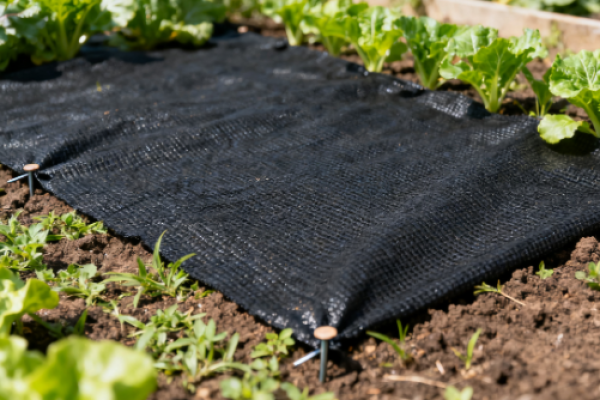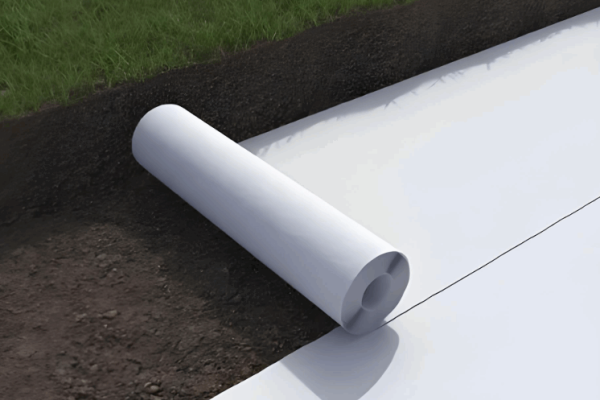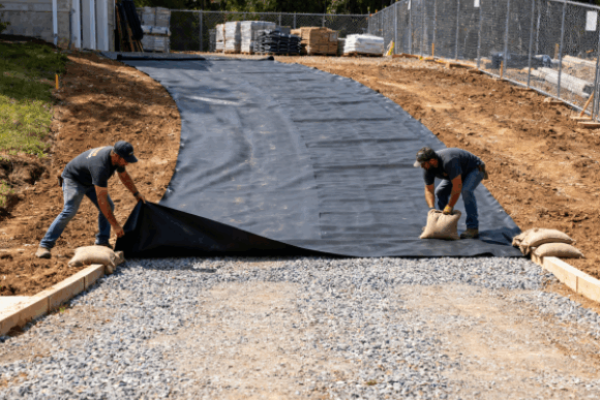Have you ever faced these frustrations:a gravel driveway that became uneven and weed-infested after a few years,or patio stones that loosened and became uneven due to an unstable base?Often,the root cause of these issues is an overlooked critical component—the lack of an effective separation layer.The geotextile underlayment,this seemingly simple material,is the unsung hero that determines the long-term durability of your landscaping projects.This guide will take you from scratch,providing a comprehensive understanding of what geotextile is,why you need it,and how to correctly select and install it,ensuring your project stands the test of time.

What is a Geotextile Underlayment?—The Basics
Geotextile,as the name implies,is a permeable synthetic textile material used in civil engineering applications.It is typically made from polypropylene or polyester and is known for being durable,permeable,and resistant to corrosion.Unlike ordinary plastic sheeting,its core value lies in its permeability,allowing water to pass through while performing four key functions:
Separation: This is the core function of geotextile.It is placed between layers of different materials(e.g.,soil and gravel)to form a physical barrier,preventing them from mixing.This effectively stops gravel from sinking into soft soil or soil from contaminating the gravel layer,thereby maintaining the integrity and function of each layer.
Filtration: Geotextile acts as an”intelligent filter.”As water flows from the upper soil to the drainage layer,it allows water to pass freely while effectively blocking fine soil particles from being carried away.This prevents the erosion of the subgrade soil,avoiding voids and settlement.
Drainage: Geotextile can collect and channel water along its plane,directing excess groundwater or rainwater away quickly.This reduces water pressure and prevents water damage.
Reinforcement: Due to its high tensile strength,when geotextile is embedded in the soil,it can distribute loads from above(e.g.,vehicle weight)through friction with the soil,enhancing the overall bearing capacity and stability of the foundation.
If you are purchasing Geotextile Underlayment, you can contact us!

Why Do You Need a Geotextile Underlayment?
Five Key Benefits of Using Geotextile
- Suppresses Weeds: By physically blocking sunlight,geotextile significantly prevents weeds from growing up from the underlying soil,saving considerable long-term maintenance effort.
- Extends Project Lifespan: Through separation and reinforcement,it maintains base stability,preventing pavement sinking and deformation,thereby extending the service life of structures like driveways and walkways for years to come.
- Improves Drainage: Effectively prevents water pooling,protecting surface materials(like pavers)from damage caused by freeze-thaw cycles and water erosion.
- Saves Long-Term Costs: While it requires a small initial investment,it significantly reduces future repair,renovation,and weeding costs,making it a highly economical investment.
- Enhances Foundation Stability: Particularly for soft ground,it effectively distributes loads,preventing uneven settlement.
Potential Risks of Not Using Geotextile
- Weed Problems: Weed seeds in the soil can easily grow through the gravel layer,becoming difficult to eradicate.
- Structural Failure: Gravel and soil mix,causing the surface to sink and form ruts.
- Poor Drainage: Soil particles clog the drainage layer,leading to water accumulation and softening of the foundation.
- High Maintenance Costs: You may face a complete overhaul within just a few years,which is time-consuming and labor-intensive.

How to Choose the Right Geotextile Underlayment?
Understanding the Two Main Types
| Feature | Non-Woven Geotextile | Woven Geotextile |
| Appearance & Feel | Similar to felt, soft texture | Similar to woven bags, smooth surface |
| Manufacturing Process | Randomly arranged fibers, needle-punched or heat-bonded | Continuous filaments oriented and bonded |
| Primary Function | Filtration, Drainage, Separation | Reinforcement, Stabilization, Separation |
| Permeability | ★★★★★ (Excellent) | ★★★☆☆ (Moderate) |
| Tensile Strength | ★★★☆☆ (Moderate) | ★★★★★ (Excellent) |
| Primary Applications | Under driveways, French drains, foundations, pavers | Road base, parking lots, retaining walls, embankments |
Key Selection Criteria
Weight: Measured in grams per square meter(g/m²).A higher weight typically indicates a thicker,more durable material.For residential landscaping,100-200 g/m²is common;for heavy-duty driveways,200 g/m²or higher may be required.
Tensile Strength: Measured in kilonewtons per meter(kN/m).A higher value indicates greater resistance to tearing and rupture,suitable for applications requiring high reinforcement.
Permeability(Flow Rate): Measures how easily water passes through the geotextile.For drainage projects,high-permeability non-woven geotextiles should be selected.
Recommendations by Project
Pavers/Patios: Recommend 100-150 g/m²Non-Woven.It provides excellent separation and drainage while offering a smooth surface for laying sand and stones.
Gravel/Stone Driveways: Recommend 150-200 g/m²or higher Non-Woven,or a light-weight Woven.Requires sufficient strength to withstand vehicle load and effectively separate gravel from soil.
Garden Paths/Landscaping Beds: Recommend 80-120 g/m²Non-Woven.Adequate for weed prevention,cost-effective,and easy to cut and install.
Ponds/Water Features: Must use specialized pond underlayment.This is a heavy non-woven fabric designed specifically to protect the pond liner(e.g.,HDPE liner)from punctures.
French Drains: Non-Woven is the preferred choice.Its excellent filtration properties prevent soil and silt from the surrounding area from clogging the drain pipe.

Geotextile Underlayment Installation Step-by-Step Guide
Required Tools and Materials
- Geotextile Roll
- Landscape Staples(U-Pins)
- Tape Measure
- Utility Knife
- Gloves
- Plate Compactor(Optional,for soil compaction)
Installation Steps
Step 1: Prepare the Base
Excavate to the required depth.Remove all existing vegetation,roots,stones,and other sharp objects.
Use a plate compactor to compact and level the soil,ensuring a firm and even sub-base.
Step 2: Lay the Geotextile
Unroll the geotextile and lay it flat over the prepared base.A common question:Which side faces up?For most non-woven geotextiles,either side is fine.For woven geotextiles,the smooth side is typically up.However,it’s best to follow the manufacturer’s recommendation.
Ensure the geotextile covers the entire area and extends to the edges.
Step 3: Overlap and Secure
Adjacent rolls of geotextile must have an overlap of 15-20 cm(6-8 inches)to ensure continuity and prevent soil from pushing through the seams.
Use landscape staples to secure the geotextile to the ground every 1-1.5 meters,especially at overlaps and edges,to prevent it from shifting when placing the top layer material.
Step 4: Trim the Edges
Carefully use a utility knife to trim any excess geotextile along the boundaries or around obstacles.
Step 5: Place the Top Layer Material
Immediately place gravel,sand,or other aggregate on top of the geotextile.Be cautious when operating machinery(e.g.,wheelbarrows,excavators)to avoid directly driving on or tearing the exposed geotextile before it is covered.

Conclusion
Though small,the geotextile underlayment is a critical bridge connecting a stable foundation to a perfect surface.Through its scientific functions of separation,filtration,drainage,and reinforcement,it transforms short-term projects into long-term assets.Making the right choice and installing it correctly once will bring you peace of mind and aesthetic appeal for years to come.
If you are looking for a reliable Geotextile Underlayment supplier,please feel free to contact us.
About Us:Lianjie
Lianjie is a one-stop supplier of geosynthetics with 15 years of professional experience and multiple national certifications.We provide the most professional Geotextile Underlayment solutions!
Reference Sources
- ASTM International:
- Relevant Standards:
ASTM D4439(Standard Terminology for Geosynthetics),ASTM D5261(Standard Test Method for Measuring Mass per Unit Area of Geotextiles). These standards define the physical and mechanical property metrics for geotextiles (e.g., weight, tensile strength).
- Relevant Standards:
- IGS (International Geosynthetics Society):
- A global professional organization that provides educational materials, technical documents, and white papers. It is one of the most authoritative sources for understanding the core functions of geotextiles (separation, filtration, drainage, reinforcement).
- Chinese National Standards (GB):
- Examples include
GB/T 17639-2008 Geosynthetics - Filament Spunbond-Needle Punched Nonwoven Geotextilesand other related standards that specify technical parameters and requirements for products in China.
- Examples include















